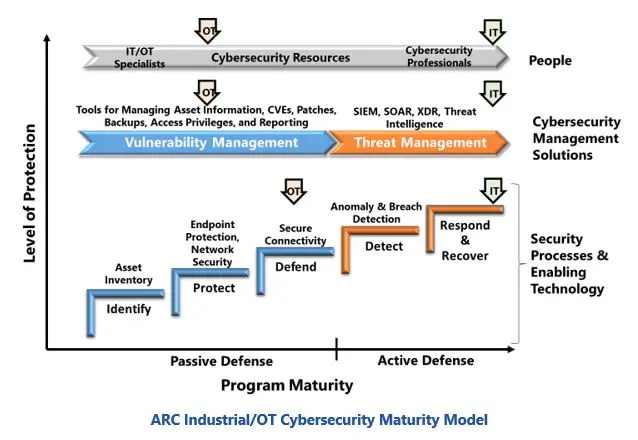

Cybersecurity has never been more challenging for industrial companies. Ransomware and political unrest are increasing the risks of safety incidents and operational disruptions. New regulations are amplifying compliance requirements. New IoT devices and connected workers are expanding attack pathways. Cloud and edge solutions are changing system architectures and security responsibilities. Changes in the industrial cybersecurity marketplace are complicating efforts to ensure sustainable cybersecurity programs.
Cybersecurity leaders need to be sure that they have the people, processes, and technologies to deal with these threats and additional workloads. Understanding what peers are doing is a good guide to what is needed and can be found in the many reports ARC published on the cybersecurity sessions at the 2023 ARC Americas Forum in Orlando. This report augments that information with insight into the changes occurring in the marketplace for industrial cybersecurity products and services.
Suppliers need to be sure that they have the products and services that end users require to maintain secure operations. They also need to be sure that they are keeping solution offerings in pace with the competition. This report is intended to help them address both issues. It distills information ARC gained through ongoing cybersecurity research, discussions with user and supplier attendees at the Orlando Forum, and a series of briefings held with suppliers across the industrial cybersecurity products and services market. It includes information about end user concerns and needs, as well as the market trends and developments that will determine the future competitive landscape.
ARC’s Industrial/OT Cybersecurity Maturity Model provides a useful tool for discussing the market for industrial cybersecurity products and services. This model provides a roadmap for implementing the security technologies, cybersecurity management solutions, and human resources needed to support the NIST cybersecurity framework recommendations. The colors in the model distinguish basic passive defensive measures needed to protect systems against conventional attacks, and those that provide the active defense capabilities needed for today’s sophisticated attacks.

A key feature of the ARC model is how it highlights the need to maintain alignment of people, processes, and technology capabilities. This includes the need for people with increasing cybersecurity expertise and cybersecurity management solutions to help defenders maintain security hygiene and manage active defense security alerts. The overall effectiveness of a cybersecurity program, or its maturity, is determined by the weakest element.
ARC research reveals significant gaps between the maturity of OT and IT cybersecurity programs in typical industrial companies. While this may have been considered acceptable in the past, today’s situation demands that these gaps are closed. And this will require significant investment in more advanced security technologies, better cybersecurity management and reporting tools, and people with more cybersecurity expertise.
The current situation creates significant opportunities for suppliers of OT cybersecurity products and services. But success of individual suppliers depends on offerings that align with user needs and include features that distinguish them from competitors. As this is a very competitive and dynamic market, success will also depend on the ability to navigate through the influx of new players and market consolidation.
The information in this report can help suppliers succeed. It provides insight into overall market drivers and inhibitors as well as the developments occurring in the individual product and service categories that will distinguish future offerings.
There are various factors driving and inhibiting growth in the industrial cybersecurity products and services market. This includes changes in user concerns and needs; regional and industrial sector developments; growth in compliance requirements; and evolution of the OT cybersecurity marketplace.
Concern about cybersecurity has significantly increased across the industrial landscape. Today, most companies are worried about ransomware disrupting their operations. Some also worry about sophisticated attacks by unfriendly nation states. Increased demand for operational data sharing has increased concern about information loss and corruption.
Companies also recognize that digital transformation activities create new cyber risks that need to be addressed. Initiatives like analytics, AI-based applications, and digital twins are introducing unproven IoT devices into critical systems and expanding OT system connectivity with the internet, cloud services and third parties. Changes in IT and cybersecurity technology are also influencing user needs and interests.
These developments are creating shifts in the strategies companies use to manage cyber risks, OT cybersecurity programs, and cybersecurity technologies. This creates opportunities for suppliers who understand their goals and offer solutions and services that support the following:
Cyber Risk Management
Integrated IT, OT, and safety cyber risk management.
Risk management focused on ensuring safe, resilient, operations.
Cybersecurity Program Management
Integrated IT and OT cybersecurity programs.
CISO oversight of security status and activities across all corporate systems and operating facilities.
Agile deployment of cybersecurity solutions and services towards the company’s most critical issues.
Cybersecurity Technologies
Cybersecurity platforms that enable solution rationalization.
Automation of security tasks and reduced the need for specialized cybersecurity expertise.
Visibility, context, and defensive capabilities for rapid response to suspicious events.
Political unrest and new regulations are driving increased demand for OT cybersecurity products and services in Europe. However, economic challenges in some of the countries are still inhibiting sales. Concerns about China have increased cybersecurity concerns and demand across the APAC region. While COVID lockdowns constrained recent sales of cybersecurity products and services in many countries, this market is recovering. Economic challenges and less concern about cybersecurity continue to limit opportunities in Latin America.
Executive Overview
Industrial Cybersecurity Products and Services
Market Drivers and Inhibitors
Product Trends and Developments
Service Trends and Developments
Recommendations
Participants in this Research
ARC Advisory Group clients can view the complete report at the ARC Client Portal.
Please Contact Us if you would like to speak with the author.
You can learn more about cybersecurity at Industrial Cybersecurity Market Analysis Research

